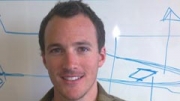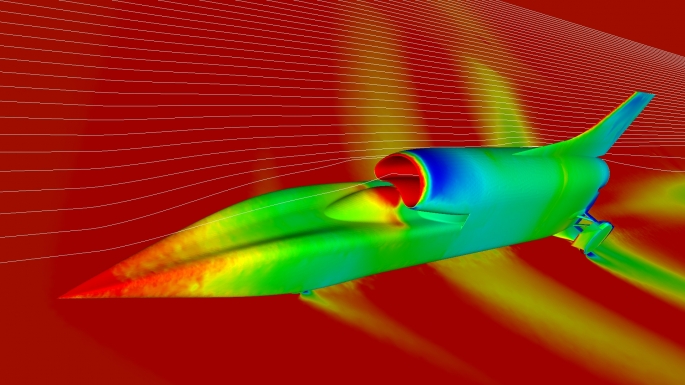
Dr Ben Evans looks back on what he and Ron Ayers have learnt about the aerodynamics of BLOODHOUND SSC since the start of the project ...
It is now just over 6 years ago that I first sat down with Ron Ayers and Richard Noble in Ron’s front room in Surrey (then the unofficial BLOODHOUND project HQ). We discussed the idea and, specifically, aerodynamic challenges of taking a land vehicle to 1,000 mph. It was pretty soon after that bizarre encounter that the picture in Figure 1 turned up on my desk at Swansea University (where I was completing a PhD at the time).
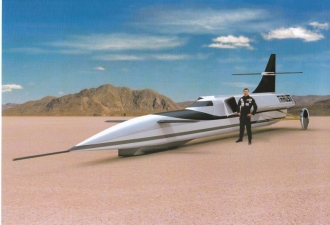 Figure 1: Early artist’s impression of the ‘yet to be named’ BLOODHOUND Land Speed Record vehicle
Figure 1: Early artist’s impression of the ‘yet to be named’ BLOODHOUND Land Speed Record vehicle
Back then, even with my Masters degree in Aerospace Engineering and a PhD in Computational Fluid Dynamics and the vast aerodynamic design experience and wisdom of Ron we were constantly being surprised by the results that our CFD simulations were throwing up. But, we were setting out to do something truly extraordinary. This wasn’t just designing a new airliner, for example, where we could build on vast amounts of prior knowledge (Comet, B747, Airbus 777, Dreamliner…. ), try and make marginal gains and create the next generation. The sheer audacious ambition of increasing the current LSR by over 30% meant that we had to start from a blank sheet of paper and not only design a new type of Land Speed Record vehicle, but also develop a whole new way of thinking.
Of course, the question of ‘can we keep the car on the ground?’ was an early topic of conversation, but we could never have guessed that this problem would cause far more of a headache at the rear of the car, than keeping the nose down at the front. This unforeseen aerodynamic behaviour led to the 6 month rear suspension optimisation study that resulted in the ‘delta fairing’ design which has been a feature since ‘config 9’. In those early front room conversations we hadn’t anticipated that getting the twin intake bifurcated duct in the original design to deliver a suitable flow to the EJ200 compressor face across the entire Mach range would be so difficult. Of course, this eventually led us to revert to a single intake above the cockpit canopy (causing significant structural headaches to be overcome). In those early days we had no real ‘feel’ for how directionally stable the car would be, which in turn meant we didn’t really have an idea of how big the fin would need to be to ‘keep the pointy end pointing forwards’ in the words of Andy Green.
In fact, for the first few iterations of aerodynamic design, where we were almost completely focussed on the question of what the external shape of the vehicle should be like and still answering the question ‘is 1000 mph even possible?’, we were constantly being surprised by the aerodynamic performance that the CFD simulations were predicting. That was not a little nerve-wracking! I would regularly turn up to engineering design meetings, face the rest of the engineers, and my report would be something along the lines of ‘this is what the CFD simulations are saying… I have no idea why…give me time’ (paraphrased!). Of course there were things we could do to investigate the causes of odd aerodynamic phenomena, such as flow visualisation (which has led to some of the famous BLOODHOUND imagery that has been available over the years (e.g. Figure 2) and force distribution breakdowns. This has allowed us (in the virtual world) to gain a far better understanding of how BLOODHOUND will behave when we begin testing next year.
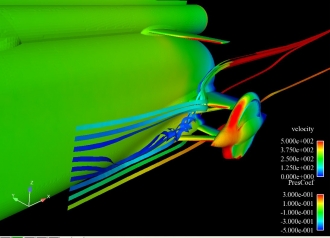 Figure 2: CFD flow visualisation of the complex flow around the rear wheels of BLOODHOUND ‘config 4’
Figure 2: CFD flow visualisation of the complex flow around the rear wheels of BLOODHOUND ‘config 4’
We really have been on quite a journey of engineering design. Figure 3 shows the journey of design evolution from 2007’s ‘config 0’ through to the ‘config 12’ design that is currently being built. One thing that you should be able to spot from this view of the design evolution is that as we have been ‘homing in’ on the optimum shape (or technically I should say ‘an optimum shape’) the extent of the geometric (shape) changes gets smaller and smaller. Anyone who has used any form of trial and error (which is essentially what we do in engineering design) will be familiar with this. But, more importantly, what else has been happening is that the aerodynamic effect of making changes to the geometric exterior has become more and more predictable.
 Figure 3: Design evolution of the external shape of BLOODHOUND from ‘config 0’ to ‘config 12’
Figure 3: Design evolution of the external shape of BLOODHOUND from ‘config 0’ to ‘config 12’In fact, with the most recent, and subtle, changes to the exterior of the vehicle, Ron and I have been able to confidently predict the impact on aerodynamic performance intuitively and have then used CFD simulations as a ‘double check’. As an aerodynamic designer this is a much happier position to be in than the early days of ‘running the CFD blind’ and crossing our fingers that we would be able to make sense of the data that came back. CFD and intuition are now working together in partnership!
The primary ‘wise after the event’ lesson that we have learned from the study is that we should have commenced by looking for a shape that was as Mach number invariant as possible. In fact, we started by incorporating our experience from subsonic vehicles which included boat-tails and rear upsweeps. The rear suspension optimisation study showed us that the boat tailing and rear upsweeps gave very Mach-dependent characteristics, and the flat sided and flat bottomed design it gave us was much better.
Of course, the question, now that we leave the virtual world behind and turn our eyes towards running in the reality of testing in South Africa (Hakskeen Pan), is whether or not this path to predictability will continue.
As an academic researcher, hoping to learn as much as possible about the behaviour of CFD algorithms in extreme applications, in some senses, I hope the answer to that is no. From an academic perspective it would be more interesting to have a new set of questions to puzzle us. But, for now we must now be patient and continue down the path to Hakskeen Pan.
Watch this space…
Dr Ben Evans
Swansea University
June 2013
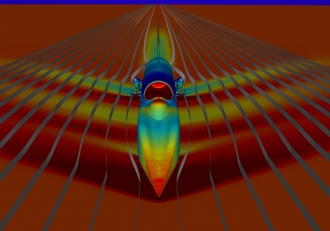 Figure 4: A recent BLOODHOUND CFD flow visualisation showing stream ribbons, and pressure colour contours
Figure 4: A recent BLOODHOUND CFD flow visualisation showing stream ribbons, and pressure colour contours
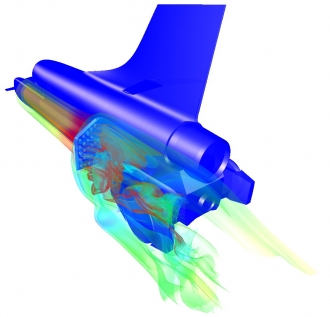 Figure 5: Stream surfaces capturing the complex flow downstream of the BLOODHOUND SSC airbrakes deployed at 60deg, Mach 0.8
Figure 5: Stream surfaces capturing the complex flow downstream of the BLOODHOUND SSC airbrakes deployed at 60deg, Mach 0.8


